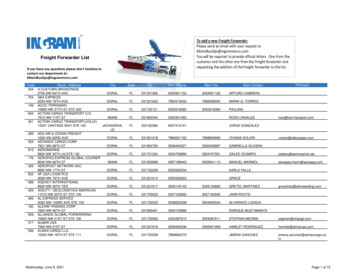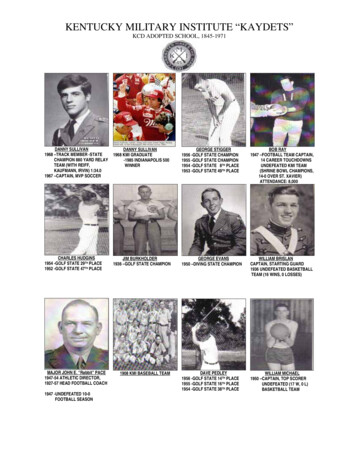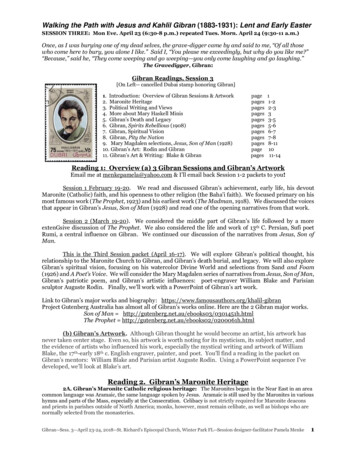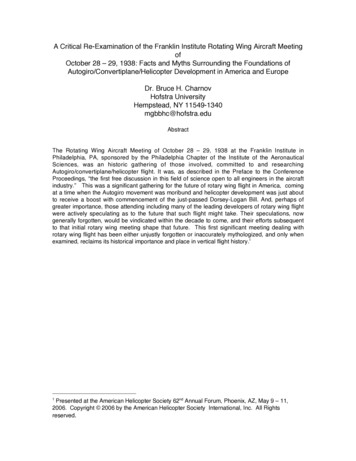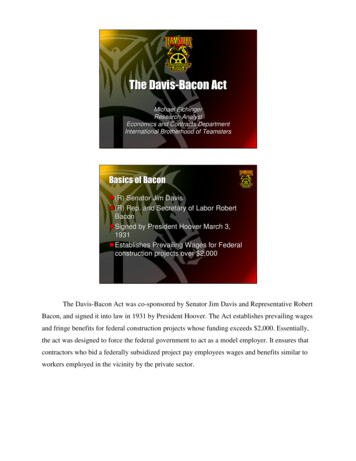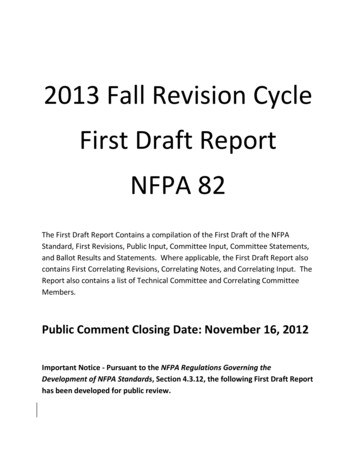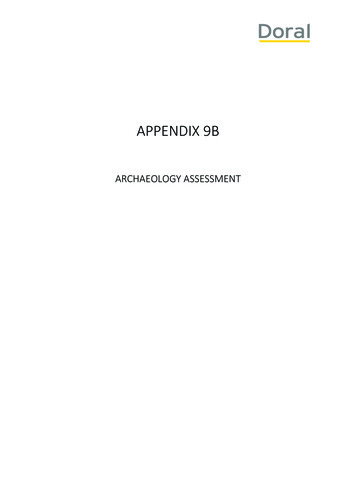
Transcription
APPENDIX 9BARCHAEOLOGY ASSESSMENT
Report on the Site Identification Archaeological Survey of theYalyalup Mineral Sands Project survey area, east of Busselton,Western Australia – November 2019.For Ethnosciences, the South West Boojarah People andDoral Mineral Sands Pty LtdConsultants Ref: 1931Kellie Cue BSc Hons (Archaeology); MAACAIRyan Hovingh BSc Hons (Archaeology)December 2019Snappy Gum Heritage Services Pty Ltd156 Francisco Street, Belmont WA 6104phone: 08 9425 5220 fax: 08 6424 8786w ww. sn ap py gu mhe ri t age.c om. auAboriginal and Torres Strait Islander viewers are warned that this report may containimages and names of deceased persons.Snappy Gum Heritage Services Pty Ltd is not responsible and accepts no liability for omissions and inconsistencies that may result from information notavailable to the writers at the time of report preparation and/or publication, including all results, conclusions and recommendations. Every effort, however, hasbeen made to ensure that all relevant data has been collated. This letter offers Preliminary Advice and the findings, conclusions and recommendations hereinmay be subject to change.
EXECUTIVE SUMMARYThis document is the final report in relation to the findings of an Aboriginal archaeological survey over theproposed Yalyalup Mineral Sands Project within tenement R70/0052, located 10.7 km east of Busselton insouth-west Western Australia. The survey area lies within the South West Boojarah #2 native title claim area(WC2006/004).Snappy Gum Heritage Services Pty Ltd (SGH) was commissioned by Ethnosciences on behalf of Doral MineralSands Pty Ltd (Doral) to undertake an archaeological survey over the proposed work area using a SiteIdentification methodology. This work was undertaken with the approval of the South West Boojarah nativetitle claimants and their native title representative body, the South West Aboriginal Land and Sea Council(SWALSC).The field investigation took place between 18 to 21 November 2019. South West Boojarah representativesWayne and Toni Webb participated in the field survey and were involved in all aspects of the work. They haveprovided input into the contents and recommendations of this report and are aware of the survey results andrecommendations. It is understood that Dr Edward McDonald will be undertaking ethnographic consultationin the near future.Doral proposes to develop a mineral sands deposit within the survey area, including the development ofopen-cut mine pits and associated infrastructure, wet concentration processing plant, solar evaporationponds, groundwater abstraction, water management infrastructure and process water pond, dams and haulroads (Bourke Snr 2019). The proposed development will include a total disturbance of 373 hectares within adevelopment envelope of 894 hectares.As a result of the archaeological field investigation: The archaeological survey within the Yalyalup Mineral Sands Project survey area is complete; No new Aboriginal archaeological places were identified or recorded; One Registered Aboriginal Site, the Abba River (DPLH Site 17354) lies across the proposed haul road; and A total of 33 isolated artefacts were recorded across the survey area.Based on these results, a series of recommendations are proposed:1) It is recommended that Doral ensure that all relevant staff/contractors are informed of the location andregistered status of the Abba River (DPLH Site 17354) on the DPLH Aboriginal Heritage Register. This sitehas historical and mythological importance and has been assessed by the ACMC to be an Aboriginal Siteunder the Aboriginal Heritage Act 1972;2) Doral should continue to avoid the above mentioned Aboriginal archaeological site where possible.3) It is recommended that should Doral require to use the land on which the Abba River (DPLH Site 17354)Registered Site exists:a)an application under section 18 of the Aboriginal Heritage Act 1972 should be submitted to theMinister for Aboriginal Affairs for consent to use the land prior to the conduct of any grounddisturbing works;b) should consent under section 18 be granted, it is recommended that Doral engage monitors(selected by the South West Boojarah people and SWALSC) to oversee ground disturbance worksalong the Abba River to ensure that no archaeological materials (surface or sub-surface) are disturbed.4) Should any cultural materials or skeletal materials/burials be identified during ground disturbance works,Doral is reminded of their obligations under section 15 of the Aboriginal Heritage Act 1972 to report thediscovery of any cultural material and/or skeletal remains/burials to the DPLH (and, in the case of skeletalmaterials, the police) and should stop work immediately.Snappy Gum Heritage Services Pty Ltd - Page 2
5) It is recommended to the ACMC that the 33 isolated artefacts are not considered to be Aboriginal sitesunder section 5 or section 6 of the Aboriginal Heritage Act 1972.6) It is recommended to Doral that the work may proceed as planned, subject to the aboverecommendations, within the Yalyalup Mineral Sands Project survey area (as listed in Appendix 1 –Completed Survey Area Boundary Coordinates).Doral is reminded that the above recommendations may be subject to change as the AHA is currently underreview. The proposed changes, if any, are currently expected to take place at the end of 2020.Snappy Gum Heritage Services Pty Ltd - Page 3
COPYRIGHTThis report and its contents and associated materials are subject to copyright and may not be copied in wholeor in part without the written consent of the South West Boojarah People, Ethnosciences, Doral Mineral SandsPty Ltd and Snappy Gum Heritage Services Pty Ltd.INTELLECTUAL PROPERTYThe parties acknowledge that all Heritage Information provided by the South West Boojarah people containedin any Confidential Report remains the intellectual property of the South West Boojarah people.DISCLAIMERSnappy Gum Heritage Services Pty Ltd is not responsible and accepts no liability for omissions andinconsistencies that may result from information not available to the writers at the time of report preparationand/or publication.SPATIAL ACCURACYData for this survey was recorded using a Garmin hand-held GPS and configured using the GDA94 coordinatesystem. The coordinates listed in the report are recorded within MGA Zone 50H. These coordinates areaccurate to within 15 m (Garmin Limited 1996).ACRONYMS & DEFINITIONSThe following acronyms are used throughout this report.GDA94Geographic datum of Australia 1994, WesternAustralia 2000ACMCAboriginal Cultural Materials CommitteeAHAAboriginal Heritage Act 1972GISGeographic Information SystemAHISAboriginal Heritage Inquiry SystemGPSGlobal Positioning SystemATSIHPAboriginal & Torres Strait Islander HeritageProtection Act 1984NTANative Title Act 1993CthCommonwealthNRTBNative Title Representative BodyDAADepartment of Aboriginal AffairsOHPOther Heritage placeDPLHDepartment of Planning, Lands and HeritageSGHSnappy Gum Heritage Services Pty LtdEPBAEnvironmental Protection & Biodiversity Act 1999SWALSCSouth West Aboriginal Land and Sea CouncilThe following definitions are used throughout this report.Aboriginal siteA site protected under the AHA on the Aboriginal Site Register, administered by DPLH.Desktop surveyAn inspection of the Aboriginal site register, reports and other relevant materials to determine thepresence or absence of Aboriginal sites or Aboriginal archaeological places within a given area.Aboriginalarchaeological placeIn the context of this report, this phrase applies to areas of cultural materials remnant of pastAboriginal occupation. These places are considered to have some archaeological significance buthave not yet been determined as Aboriginal sites under AHA by the ACMC. Other types of significancemay also apply.Isolated artefactAny artefacts that are not considered to fall within an Aboriginal archaeological place or site and areconsidered to have little or no archaeological significance.Snappy Gum Heritage Services Pty Ltd - Page 4
CONTENTSEXECUTIVE SUMMARY . 2Copyright . 4Intellectual Property. 4Disclaimer . 4Spatial Accuracy . 4Acronyms & Definitions . 4CONTENTS . 5List of Figures. 6List of Tables . 6INTRODUCTION . 7Proposed Development Area. 7Environmental Context . 8Regional environment . 8Local environment . 9Legal and Ethical Context. 11Archaeological Context. 13Timing and nature of human occupation . 13Life-style patterns and behaviour . 14Broad scale and local group social interactions . 15Post-European settlement and Aboriginal life-ways . 16SURVEY METHODS . 17Archaeological Site Survey Strategy . 17Overview . 17Desktop research methods. 17Field survey process . 18Archaeological Assessment . 19SURVEY RESULTS . 23Desktop Survey Results . 23Previous heritage surveys and previously-recorded Aboriginal archaeological sites/places . 23Information from previous research, heritage surveys and recorded sites. 23Field Survey Results . 25Survey request considerations . 25Aboriginal archaeological places . 25Isolated artefacts . 25DISCUSSION . 26Recommendations for management . 26CONCLUSION AND RECOMMENDATIONS . 27REFERENCE LIST . 28APPENDICIES . 33APPENDIX 1 – Completed Survey Area Coordinates. 33APPENDIX 2 – Isolated Artefacts Data . 2APPENDIX 3 – AHIS searches within 200 m of the survey Area . 3Reports . 3Registered sites . 4Snappy Gum Heritage Services Pty Ltd - Page 5
Other Aboriginal archaeological places . 5LIST OF FIGURESFigure 1: Overview of survey area. .10LIST OF TABLESTable 1: Survey participants – 18 to 21 November 2019. 7Table 2: Yalyalup Mineral Sands Project survey area summary. . 8Table 3: Existing Aboriginal archaeological sites/places that intersect with the Yalyalup Mineral Sands Projectsurvey area. .23Table 4: Summary results of field investigations with the 2018 WAN survey requests. .25Snappy Gum Heritage Services Pty Ltd - Page 6
INTRODUCTIONThis document is the final report in relation to the findings of an Aboriginal archaeological survey over theproposed Yalyalup Mineral Sands Project within tenement R70/0052, located 10.7 km east of Busselton insouth-west Western Australia. The survey area lies within the South West Boojarah #2 native title claim area(WC2006/004).Snappy Gum Heritage Services Pty Ltd (SGH) was commissioned by Ethnosciences on behalf of Doral MineralSands Pty Ltd (Doral) to undertake an archaeological survey over the proposed work area using a SiteIdentification methodology. This work was undertaken with the approval of the South West Boojarah nativetitle claimants and their native title representative body South West Aboriginal Land and Sea Council(SWALSC).The field investigation took place between 18 to 21 November 2019. South West Boojarah representativesparticipated in the field survey (Mr Wayne Webb is a member of the South West Boojarah native title claimand is an active participant with SWALSC – see Table 1) and were involved in all aspects of the work. They haveprovided input into the contents and recommendations of this report and are aware of the survey results andrecommendations. It is understood that Dr Edward McDonald will be undertaking ethnographic consultationin the near future.Table 1: Survey participants – 18 to 21 November 2019.SGHKellie CueTessa WoodsRyan Hovingh ** Present 20 November 2019South West BoojarahWayne WebbToni WebbThe purpose of this report is to:a)Record any newly identified Aboriginal archaeological places within the survey area to inform Doralof its location;b) describe the archaeological significance of any new Aboriginal archaeological places recorded usingthe Site Identification method; andc)to provide recommendations on the management and protection of these Aboriginal archaeologicalplaces within the proposed development areas.To this end, the following report will provide an introduction to the project, environmental context and thesurvey methods employed; an analysis of the desktop survey and the field results; and a discussion of theinvestigation. Recommendations are presented based on the results, with new Aboriginal archaeologicalplaces discussed with respect to their potential to contribute to archaeological research in the wider SouthWest region as well as the broader Australian landscape. To provide a background, this report will outline thecontext regarding archaeological research in the South-West and will discuss the key themes in Australianarchaeology. An outline of the legal and ethical context regarding the recognition, protection andmanagement of Aboriginal heritage under State and Commonwealth legislation is also described.PROPOSED DEVELOPMENT AREADoral proposes to develop a mineral sands deposit within the survey area, including the development ofopen-cut mine pits and associated infrastructure, wet concentration processing plant, solar evaporationponds, groundwater abstraction, water management infrastructure and process water pond, dams and haulroads (Bourke Snr 2019). The proposed development will include a total disturbance of 373 hectares within aSnappy Gum Heritage Services Pty Ltd - Page 7
development envelope of 894 hectares. Much of the disturbed area is on cleared agricultural land. The life ofthe mine is expected to be up to 5.5 years. Summary information is listed in Table 2.Table 2: Yalyalup Mineral Sands Project survey area summary.Survey areaProposed activityWork ProgramTenement No.Area (km2)Yalyalup Mineral SandsProjectSand mining, infrastructure andhaul roadSite IdentificationR70/529.3ENVIRONMENTAL CONTEXTRegional environmentThis section provides a summary of the regional environment to understand the context in which pastAboriginal people may have lived and moved through country.The Yalyalup Mineral Sands Project survey area is situated on the Swan Coastal Plain, between 9.7 km and15.3 km south-east of Busselton. The Whicher Scarp abuts the eastern boundary of the Swan Coastal Plainapproximately 3.5 km to the east of the survey area.The Swan Coastal Plain extends from Jurien in the north to Dunsborough in the south and is comprised of anapproximately 20 – 30 km wide strip running roughly parallel with the south-west coast of Western Australia(Gibbs 2011; Webb, Keighery et al. 2009). It is composed of Quaternary sediments of alluvial and aeolian origin,with the Yalyalup Minerals Sands Project survey area located atop the Pinjarra Plain, one of the six majorlandforms of the Swan Coastal Plain (Webb, Keighery et al. 2009). The Pinjarra Plain is an alluvial plain ofPleistocene to Holocene age, originating from the river systems flowing down from the plateaus (AstronEnvironmental Services 2013; Government of Western Australia 2000). As per Webb, Keighery et al. (2009:10):“The Pinjarra Plain is composed of alluvial (riverine) and colluvial (erosional) deposits. These deposits havebeen eroded from the adjoining Blackwood and Darling Plateaus and deposited over the last three millionyears by the alluvial fans of rivers and streams, as the flow rates slow and there is a loss of sediment carryingcapacity.”The Pinjarra Plain can be divided into upland and wetland areas and is generally very poorly drained (Moore2001; Webb, Keighery et al. 2009). The Abba and Sabina Rivers are the major water systems local to the surveyarea, both of which flow west into the Geographe Coastal Wetlands. Jarrah (Eucalyptus marginata) and marri(Corymbia calophylla) forest historically covered much of the upland areas (though this has now mostly beencleared) (Patrick 2005). Forest blackbutt (Eucalyptus patens) grows with Marri near rivers, with River Gum(Eucalyptus rudis) and Paperbark trees (Melaleuca rhaphiophylla) present along watercourses. Low Paperbarkwoodland was present in the wetlands and swamps, along with grass trees (Kingia australis) and the occasionalChristmas Tree (Nuytsia floribunda). Low open forest with Banksia spp., Nuytsia spp. and Melaleuca speciesoccurs on more sandy soils.The Yalyalup Mineral Sands Project survey area is located within the Abba Plain soil-landscape system (BourkeSnr 2017). The Abba soil system contains a combination of a sandy grey brown duplex, alluvial soils, bleachedsands, both shallow and deep red brown sands and loams over ironstone, and clay subsoils (Bourke Snr 2017).This southern section of the Swan Coastal Plain was attractive for Aboriginal people because it was wellwatered and rich in resources year-round (Gibbs 2011), with groups tending to move around the landscapeas seasonally available resources required. The current survey area and its surrounds were comprised ofextensive wetlands until European colonisation when agricultural activities were introduced, with nativevegetation cleared and the land altered to remove the water (through modifications to the river systems andthe construction of drainage channels) and achieve ideal farming conditions (Environmental ProtectionAuthority 1993). Drainage channels were built across most of the local area to divert much of the low lyingwaters towards the larger rivers to “prevent the backing up of water during winter periods to much rich,Snappy Gum Heritage Services Pty Ltd - Page 8
cultivable land, and would further assist in the drainage of group settlements in the vicinity” (The Daily News1927).Local environmentOf the 8.94 km2 (894.17 hectares) within Doral’s Yalyalup Mineral Sands Project development envelope, atleast 76.65% has been cleared of native vegetation (6.85 km2, or 685.45 hectares) and is now classified ascleared pasture (Bourke Snr 2017). These are highly degraded areas consisting of paddocks, roads anddwellings.Only a few narrow tracts of native vegetation exist within the survey area, primarily along the banks of theAbba and Sabina Rivers and along McGibbon Track. Vegetation in these areas includes Eucalyptus spp. trees(Eucalyptus marginata and Eucalyptus rudis), Melaleuca spp. trees (paperbarks), Banksia littoralis (SwampBanksia), as well as Hakea spp. and Acacia spp. shrubs, with a thick understory of native weeds and sedges.Ground surface visibility in these areas is extremely poor, owing to heavy leaf litter and an overcrowdedunderstory.Pine trees have been planted in belts within some properties, likely to aid in stabilising the fine sandy ground.Some small areas of vegetation rehabilitation (or attempts at it) were observed, though these tended to bealong the roadways. The only other native vegetation noted were lone Eucalypts that were dotted across thepaddocks (providing shade for cattle, with all other native vegetation around them removed).Through the paddocks, there is no ground surface visibility except where cattle congregate at gates and watertroughs. Continuous trampling at these locations has removed the introduced grasses, leaving small sandyopenings. These are generally comprised on super fine white/grey sands, with a few veins of yellow sandoccasionally visible. Coffee rock was noted in places, as were a few small pieces of shell which alludes to thefact that these lands were once ocean floor when the sea levels were higher. The survey area is generally quitelow-lying, with a few low rises noted in a roughly north-east to south-west orientation through the easternLots.Cattle and vehicle tracks cross through all properties. Dams and rubbish pits have been constructed. Wherethe Abba River intersects with the survey area, it is clear from the surrounding landform that the river has beenmodified to increase drainage. Drainage channels are visible cutting through most the paddocks, which weredug to drain water off the wetlands to make way for usable paddocks.Snappy Gum Heritage Services Pty Ltd - Page 9
0Figure 1:Overview of survey area.Survey AreasYalyalup Development EnvelopeHeritage Places10,730Places listed on the RTIO database.ElevationContoursTransportPrincipal RoadMinor RoadTrackSecondary RoadDual CarriagewayMinor RoadPrincipal seConnectorNon-perennial LakesUtilitiesPowerlineGas PipelineWater PipelineTopographic FeaturesBorePlace NameHomesteadLocationVASSEH02kilometresScale: 1:54,240Compiled by: Ryan HovinghDate: 19 December 2019Projection: GDA94 Zone 5025 Baningan Avenue, Success WA 6164phone: 08 9425 5220 fax: 08 6424 8786www.snappygumheritage.com.auI GHWAYTopographic Data: Commonwealth of Australia ( GeoscienceAustralia ) 2011. The Commonwealth gives no warrantyregarding the Data’s accuracy, Commonwealth’s liability forbreach of any statutory warranty is limited to replacement of theData, supply of equivalent data, or refund of the purchase price.The Commonwealth disclaims all other liability for any loss,damage, expense and cost incurred by any person as a resultof relying on the information and Data in the CD.Aboriginal Site Data Dept. of Indigenous Affairs, WA
LEGAL AND ETHICAL CONTEXTAboriginal archaeological surveys take place within a legal and ethical framework that underpins surveymethods, survey findings, cultural heritage recommendations and the approvals process.There are a number of Commonwealth and State Acts that provide for the recognition, protection andmanagement of indigenous rights and interests in relation to land and heritage. In Western Australia, theAboriginal Heritage Act 1972 (WA) (AHA) provides the principal legislative framework for the protection andpreservation of places and objects that are of significance to Aboriginal people and their cultural heritage. TheAHA is administered by the Minister for Aboriginal Affairs, who must consider the recommendations of theRegistrar for Aboriginal Sites and the Aboriginal Cultural Material Committee (ACMC), although the Ministeris not bound by such recommendations.It is important to note within the context of this report that the manner in which the information is presentedto the ACMC, the decisions about what constitutes an Aboriginal Site and the way they are managed hasvaried since the inception of the AHA. For example, early practitioners applying the AHA, including the ACMC,were keen to protect Aboriginal cultural material, including isolated artefacts and small artefact scatters.Further, the use of GPS technology was not present for early site recordings and, was not widely used untilapproximately 1998. Large buffers were, therefore, placed around sites to minimise potential impact. Theselegacy issues are still existent today. With the increase in mining and land development practices, an increasein the number of heritage investigations and the number of resultant identified Aboriginal Sites, the systemhas been placed under a lot of pressure to change the way the AHA is managed within the governmentdepartments. The Aboriginal Heritage Due Diligence Guidelines was one such measure adopted in 2013(Department of Aboriginal Affairs 2013).Governmental changes to heritage management are discussed and/or implemented every few years, withproposals ranging from formal a
Snappy Gum Heritage Services Pty Ltd - Page 3 5) It is recommended to the ACMC that the 33 isolated artefacts are not considered to be Aboriginal sites under section 5 or section 6 of the Aboriginal Heritage Act 1972. 6) It is recommended to Doral that the work may proceed as planned, subject to the above recommendations, within the Yalyalup Mineral Sands Project survey area (as listed in .
